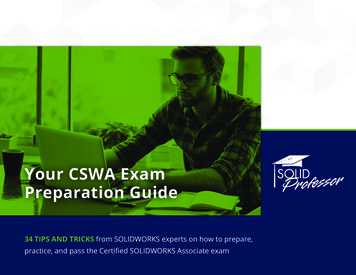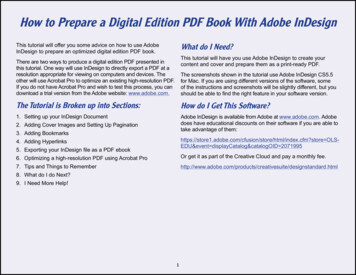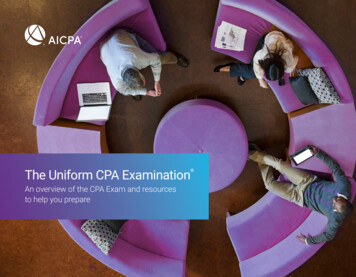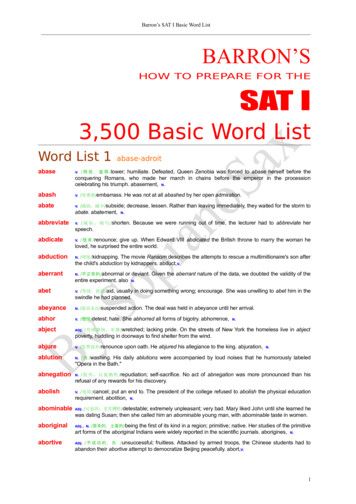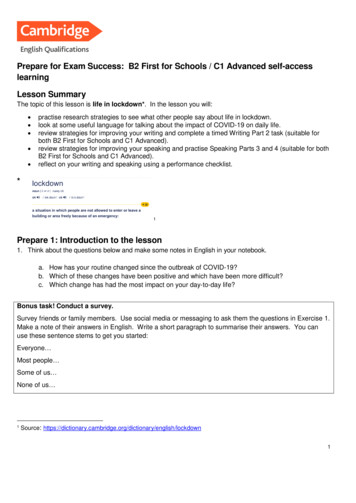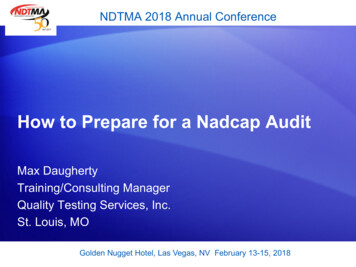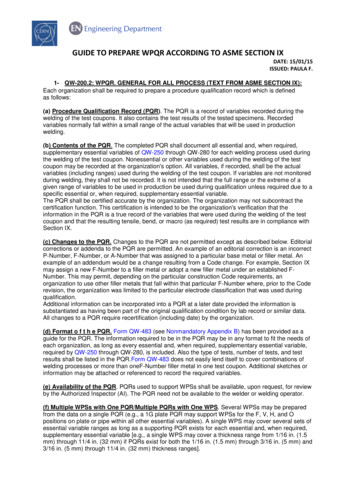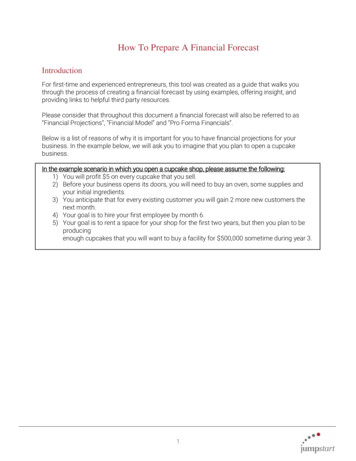
Transcription
How To Prepare A Financial ForecastIntroductionFor first-time and experienced entrepreneurs, this tool was created as a guide that walks youthrough the process of creating a financial forecast by using examples, offering insight, andproviding links to helpful third party resources.Please consider that throughout this document a financial forecast will also be referred to as“Financial Projections”, “Financial Model” and “Pro Forma Financials”.Below is a list of reasons of why it is important for you to have financial projections for yourbusiness. In the example below, we will ask you to imagine that you plan to open a cupcakebusiness.In the example scenario in which you open a cupcake shop, please assume the following:1) You will profit 5 on every cupcake that you sell.2) Before your business opens its doors, you will need to buy an oven, some supplies andyour initial ingredients.3) You anticipate that for every existing customer you will gain 2 more new customers thenext month.4) Your goal is to hire your first employee by month 6.5) Your goal is to rent a space for your shop for the first two years, but then you plan to beproducingenough cupcakes that you will want to buy a facility for 500,000 sometime during year 3.1
A Financial Forecast Is Important For an Early-Stage Company BecauseIt:1. Determines the feasibility of how your company plans to make money to grow. How many cupcakes would you need to sell in order to pay your monthly rent, payyourself, and have enough money left over to hire an employee by month 6? Is that amount of cupcakes feasible considering the constraints of time, money, space,number of potential customers, etc.?2. Forecasts the cash investment needs your business will require (initially and in the future). How much money will you need to initially spend to buy an oven and the supplies thatyou’ll need in order to start making your cupcakes? In what month will you be making enough cupcakes that you outgrow your rented spaceand need to buy a facility? How much money will you have in your bank account at thistime? If you don’t have enough money in your bank account to buy the new facility with cash,how much money will you need to raise from a loan, grant, or venture capital?3. Offers you a “game plan” to help you, your team, advisors, and investors understand yourvision. Everyone should be on the same page and working toward the same goals on the sametimeline4. Provides you a “scorecard” that you can refer to when comparing what you anticipated yourfinancial performance to be at a given time versus the actual numbers at that time. Fast-forward to 12 months after you opened your business. Are you making more or lessmoney than you projected in your financial forecast? Why?5. Supplies you a “vital signs chart” that you can use to access the health of your company soyou can prescribe solutions that lead to success. Fast-forward to 12 months after you opened your business. If you have done better thanyour initial projections, what caused your success? How can you do more of what hasmade you successful? If you have not been as successful as your initial projections predicted, what caused theshortcomings? What can you do to improve?6. Gives investors insight into your assumptions used to project how your company will succeed. Some potential investors may know nothing about the cupcake business, but yourfinancial projections will help them understand the industry. If an investor is going to give you money to buy your cupcake facility, they’re going to wantto understand how your business is going to grow to the extent that they profit on theirinvestment. Investors want to understand the upside-potential and downside-risk of funding yourbusiness. For example, how will it affect your revenue if each of your customers attracts 3new customers (as opposed to the original assumption of 2 new customers)? What if theyonly draw 1 new customer?It’s All About Assumptions!2
Assumptions are things that you assume are true or predict will happen. People makeassumptions based on past knowledge or by educating themselves on a particular subject. Forexample, if the sky is blue with no clouds then one would assume that it is not raining.Financial forecasts are never 100% accurate at predicting the future performance of yourbusiness. Unless you have a time machine, you will have to develop assumptions around howyour business will grow.A List of Common Assumptions Needed For Financial ProjectionsPlease see below for a list of common assumptions that you might be expected to make whencreating your financial projections. Not every assumption listed will be relevant to your specificbusiness. The sentences are incomplete so you can imagine filling in the blanks to complete theassumptions for your business. It will take my business months to reach a particular goal.needs to be purchased in order to start my business (ex: equipment, property lease, etc.)The in startup money needed in order to start and grow my business will comefrom ex: personal funds, grant, loan, equity investor, etc.).We will sell (ex: 100, 70,000, 4,000,000, etc.) units of product by month (1, 12, 18, etc.)Each month my sales will grow by % (ex: 25%, 50%, 400%, etc.)My business will grow by (ex: 100, 1000, 5000, etc.) customers each month.My business will have monthly expenses of .Expenses will increase/decrease each year by % (ex: 5%, 10%, 20%, etc.).My business will have (ex: 2, 4, 10, etc.) employees by month (ex: 1, 6, 18, etc.)Employees will be paid per month and each year their wages will increase by %(ex: 5%, 10%, 20%, etc.). I will be paid each month.Every spent on marketing will produce (ex: 1, 20, 100, etc.) new customer(s).A salesperson can sell (ex: 2, 20, 400, etc.) units each month.Sales commissions paid to the salespeople will be % (ex: 5%, 10%, 25%, etc.) of each sale.The sales cycle is days/months (ex: 1, 6, 12, etc.)The cost of the goods I use to create each unit of my product costs .The costs to acquire a new customer will be .Customers will be billed on a basis (ex: one-time-basis, monthly, quarterly, annual, etc.)It will take (ex: 1, 6, 12, etc.) days/months to receive payment from customersTaxes will be per month.My business will burn through before we make money in month (ex: 1, 6, 12,etc.)If I decrease or increase any of the above assumptions by a % (ex: 5%, 10%, 20%, etc.), itwould affect the financial health of my company by .Don’t Be Intimidated–BE EXCITED To Create Your Assumptions!3
Be excited about this opportunity. By creating your forecast, you will come to understandyour business better than you ever have before. Like peering into a crystal ball, this will beyour first glimpse into what the future holds. No one expects you to know everything. Great entrepreneurs accept what they knowversus what they don’t know. You might know how to bake the tastiest cupcake in theworld, but maybe you have no idea how to market your product and how much thoseefforts will cost. Leverage your team. If you have business partners, make building a financial forecast ateam exercise. It’s very possible your partners know an aspect of the business better thanyou. Seek outside help. Friends, family, past co-workers, community organizations, etc. are allresources you can turn to for further insight on your assumptions. Do your homework. Thoroughly research every aspect of your business represented inyour projections.o Many industries will have competitors that are publically traded. With a quickinternet search you should be able to find the financial statements for some of themost established players in your industry. These companies have spent years andboatloads of money on creating their financial statements. You can access thesedocuments for free and use them as guides when creating your own projections.Click here to search for public companies’ filings with the SEC.o Do your own primary research [insert customer discovery tool]o Are you a Software as a Service (SaaS) startup looking for industry benchmarks? Click here for Part 1 of the 2015 Pacific Crest SaaS Survey Click here for Part 2 of the 2015 Pacific Crest SaaS Survey Make several versions (aggressive, moderate, and conservative) of your forecast.o Because no one can accurately predict the future, it’s advised that you makeseveral versions of your forecast to reflect the following scenarios: Aggressive – this forecast reflects your business success exceeding yourexpectations. For example, say you rationally assume that your sales willgrow by 10% each month. In your aggressive forecast you would havesales maybe growing at 20% or more. Moderate – this forecast will reflect your rational predictions. For example,if you rationally predict 10% sales growth, this forecast will reflect salesgrowing at 10%. Conservative – this forecast will reflect your business falling short of yourexpectations. For example, if you rationally predict 10% sales growth, thisforecast will reflect sales growing at 5% or maybe less.o Being prepared for different scenarios will build your confidenceBe Able To Explain Each One Of Your Assumptions4
Be very critical of the assumptions you include in your forecast. Second guess each ofyour assumptions until you clearly understand why you chose them. Record every assumption that you use in your financials so you can easily refer back tothem. Explain your assumptions thoroughly to yourself and others. It is often more important toable to successfully explain the thought process and logic that you used to determineyour assumptions than it is to be accurate at predicting the future. Have research and data to refer to (whenever possible) to support your assumptions.Click here to read more thoughts on making assumptions5
Projecting Expenses and RevenuesExpensesExpenses are often the easiest piece of your forecast to predict.Click here for historical data that gives insight into the percentage of revenue that certainindustries allocate to various common expenses. Please note that these industry benchmarksmay not be relevant to your specific business.You can break your expenses into four categories:1) One-Time Expenses These are expenses that you will only incur once, very infrequently, and/orirregularly. Many of these expenses will be paid at the beginning of the life of your business. Examples: purchase of a building, realtor fees, purchase of office furniture On a scrap sheet of paper create a table similar to the one below. In the table youcreated try to list all the one-time expenses you plan to incur.Name of Expense Dollar AmountOffice Furniture 1,000 Date1/1/2016/ // // /2) Variable Expenses Tied directly and proportionately to changes in production amount or number ofunits sold. For example, if the raw materials used to make your product cost 2.00 per unit,then the costs will be 200 if 100 units are sold and 200,000 if 100,000 units aresold. The total amounts of these expenses will likely change over time. Examples: raw materials, packaging, hourly production wages, sales commissions,inventory, shipping costs. On a scrap sheet of paper create a table similar to the one below. In the table youcreated try to list all the variable expenses you plan to incur.o The “Driver” column is for you to list the aspect of the business that aparticular cost is tied directly and proportionately to. For example, theamount of packaging that you will need to buy will be directly proportionalto the amount of units you sell. For instance, if you sell 100 units then youwill need to purchase 100 units worth of packaging.6
Name of ExpensePackagingCost Per Unit 3.00 DriverAmount of units sold3) Fixed Recurring Expenses (non-labor) Are not dependent on changes in production amount or number of units sold. Whether you sell 100 units or 100,000 units, these costs will remain the same. They will likely be the same amount each week, month, year, etc. Examples: rent, insurance, dues and subscriptions, equipment leases, payments onloans, depreciation, and advertising. On a scrap sheet of paper create a table similar to the one below. In the table youcreated try to list all the fixed expenses (non-labor) you plan to incur.o The “Frequency of Charge” column is for you to list how often you will haveto pay that particular expense. Most fixed charges listed on your forecastwill be on a monthly basis, but some charges might be on a quarterly basisor a bi-annual basis (2 charges a year).Name of ExpenseRentDollar Amount 700 Frequency ofChargeMonthly4) Fixed Recurring Expenses - Labor Costs Labor costs are often the highest costs for early-stage companies Most financial projections will include a “Salaries” or “Headcount” tab or section Typically, labor costs are listed on a monthly basis There are generally 2 metrics to consider when you are determining labor costs:1) The annual pay for a specific position (divide number by 12 to determine themonthly pay).2) The hire date for each individual Please see below for a simple example of a labor costs section. On a scrap piece of paper or in an excel doc, try to create your own table similar tothe one below.o Remember, you’re just making assumptions! Make your best guessesregarding how much money you will have to pay each position and whenyou will be hiring them.o Use this tool for guidance on what the average pay for certain positions isin the US7
TitleCEOSalespersonCall RepCall Rep 2AnnualPay 60,000 48,000 36,000 36,000MonthlyPay 5,000 4,000 3,000 3,000Hire Date1/1/20163/1/20165/1/20166/1/2016Jan 5,000Feb 5,000Mar 5,000 4,000Apr 5,000 4,000May 5,000 4,000 3,000Jun 5,000 4,000 3,000 3,000 5,000 5,000 9,000 9,000 12,000 15,000Revenue Revenue or a sales forecast can be challenging to predict.R
The _ in startup money needed in order to start and grow my business will come from _ ex: personal funds, grant . The cost of the goods I use to create each unit of my product costs _. The costs to acquire a new customer will be _. Customers will be billed on a _ basis (ex: one-time-basis, monthly, quarterly, annual, etc.) It will take _ (ex: 1, 6, 12, etc.) days .
